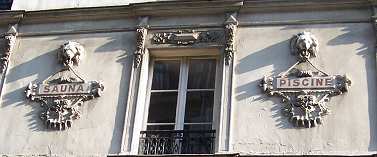The Marais4th arrondissement, Hotel de Lauzun, Notre Dame |
|
|
The History of the MaraisThe Marais was originally a marsh, in fact that is what marais means. In its heyday was full of beautiful hotels (town houses, not places where you could rent rooms by the day), most of which had a similar layout - the gateway and courtyard in front, then the house, and in the back the private garden (entre, cour et jardin). The photograph on the left shows one of the courtyards today, unfortunately many are now behind closed doors, but if a door opens do have a peep in. The streets in those days had no pavements as the gentry rode on horseback or in a carriage, so that explains the narrowness of the streets today. It became the fashionable place to live after 1365 when the future Charles V moved there. However at this time the rue Saint-Antoine still had an open sewer running down it, so the area was pretty smelly. Jewish community in the MaraisDuring the 13th and 14th centuries there had been a Jewish community centered around rue des Rosiers, but the Jews were exiled from France in 1394. There were always a few who managed to stay on, but it was not until 1791, when the ban was lifted, that they were allowed to return in any numbers. In rue des Rosiers toady there are many shops selling Jewish foods, and the smell is tantalising. Place Royale, Place des VosgesThe building of the Place Royale in 1612 (today's Place des Vosges) kept the Marais as the top are to live in. It was the first open square in Paris, and was a favourite location for duels, as the spectators could watch from the balconies. There are 36 houses, 9 on each side. Victor Hugo wrote Les Miserables while he lived in one of the houses. Place des Vosges got its new name when the district Vosges was the first to pay its taxes to the new government of Napoleon. Above right shows a fountain in Impasse de la Poissonerie. When Louis XIV moved the court to Versailles in 1682 the Marais started to decline. The revolutions caused huge damage to the once great houses, and in the 19th century most were converted to workshops for artisans and dwellings for the poor. |

 |
|
In 1962 Andre Malraux managed to get a bill passed through the National Assembly which led to the Marais being declared a protected zone. And since then things have improved so much that it is once again a fashionable area to live, work and shop. However even as late as the 1960s 60% of apartments had no running water or WC. Many of the original shop signs have been preserved even if they bear no relationship with what is now sold in the shop. See the baker's above left and right, and the sign for the pool and sauna above left. The trompe l'oeil on the left is above one of the many restaurants in the area. |
||
 |
|
|
Rue Francs-Bourgeois forms the border between the 3rd and 4th arrondissements, and runs along what was once part of the northern section of the city wall built by Philippe-Auguste. Today it is a fashionable shopping street. On the right is the corner of rue Francs-Bourgeois and rue Pavee. The Bastille, some famous prisonersThe area is bordered on the west by the Place de la Bastille, which held the fortress with eight towers built in the 14th century to fend off the English. By the 17th and 18th century it had become a prison. It is reported that this is where Louis XIV ordered the "man in the iron mask" to be held. Voltaire was also imprisoned in the Bastille, in fact he wrote a play while he was imprisoned. The Marquis de Sade was another famous prisoner, and had his wine shipped in from his own vineyards. 10 days before the storming of the Bastille which signaled the start of the revolution the Marquis was transferred to an asylum. When the Bastille was stormed there were only 7 prisoners to be set free, 4 forgers, 1 accomplice to a murder, a count imprisoned for incest, and a madman. |
||
|
||
 |
copyright2003-2012 |








